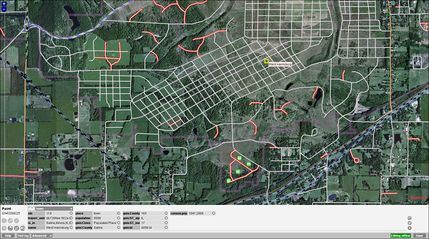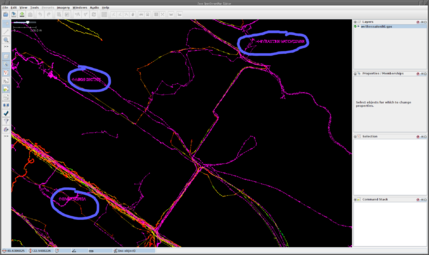Ko:Vandalism

훼손행위(Vandalism)은 데이터 편집에 관한 오픈스트리트맵 커뮤니티의 합의된 규범을 일부러 거스르는 행위입니다. 단순한 실수나 편집 오류는 '훼손행위'로 보지 않지만, 훼손행위에 대응할 때 쓰는 연장(tool)으로 되돌려야 할 수도 있습니다.
커뮤니티의 합의 규범을 위반하는 다른 유형에 대해서는 잘못된 사용을 보십시오.
훼손행위와 또다른 유형의 잘못된 편집 행위

'훼손행위'의 진짜 의미는 지도에 "낙서"를 하는 것으로, 유치한 장난이나 일부러 오픈스트리트맵을 망가뜨리려고 하는 행위입니다. 진정한 훼손행위는 드물게 일어나는 편입니다. 오픈스트리트맵은 비영리 공익 단체이며, 지도 데이터는 커뮤니티의 '소유'입니다. 대부분의 사람들은 이를 존중해 주고 있습니다.[1]
훼손행위하고 매우 비슷하게 악의적 편집의 여러 '또다른 유형'이 있으며, 유치한 장난을 넘어 다양한 동기를 가지고 행해지지만 결국에는 같은 복구 조치가 필요합니다. 이런 행위에는 다음이 포함됩니다:
- 저작권 위반
- 오픈스트리트맵 데이터베이스 안에서 일어난 분쟁(이른바 '편집 전쟁')
- 위키에서 일어난 분쟁
- 알맞지 않은 봇을 쓰는 일
- 되풀이하여 일어나는 방해 행위
- 스팸질
- 올바른 것으로 인식되는 데이터를 일부러 없애거나 품질을 떨어뜨리는 일
- 일부러 잘못된 데이터를 올리는 일
- 논의되지 않은 가져오기
단순한 실수나 편집 오류는 훼손행위로 보지 않지만, 그 가운데는 되돌려야 하는 것도 있을 수 있습니다.
훼손행위에 대한 대응
초보자를 위한 정보
지도에서 실수나 (악의적이건 아니건 간에)몇몇 잘못된 것을 찾아냈을 때 무엇을 어떻게 해야 할지 혼란스럽거나 확실하지 않을 수 있습니다. 이런 경우에는 다른 매퍼에게 연락하여 도움을 구하십시오. 하지만 이 페이지의 정보가 도움이 될 수도 있습니다.
일반적 지침
The view from a discussion on talk in September 2009 was:
- We should expect that all contributors should at all time attempt to make good, accurate and well researched changes
- We need to ensure that every contributor is on-balance making the dataset better, not worse. If the contribution is in doubt we owe it to other contributors to investigate and respond.
- We should be aware that people make mistakes, need time to learn and newbies often need and will respond to support
- We can request, but not require contributors to add comments to their changesets and to have created a useful personal page with some details about their interest and knowledge. Doing this makes reversion less likely and make it more likely that the person will be helped if needed.
- In the event that someone seems to be doing strange edits one should initially assume "good faith" but should watch carefully and discuss with others if appropriate.
- If a significant number of edits to ways can be definitively proved to be malicious, obscene, libelous or it is considered that they might bring the project into disrepute then the related change-sets can be reverted immediately without discussion and without 100% checking of the rest of the change-set.
- If the edits are dubious but it can't be proved to be incorrect then we should contact the person and ask for some additional information. If we don't get a reasonable response (or gets no response) and the dubious edits continue and there are not a good number of balancing clearly positive contributions then we should look to prove at least one bad edit and may then come to the decision in discussion with others that it is appropriate to revert the change-set in question and potentially all changesets by that person.
- Once someone has been identified as a problematic contributor then one only needs to perform a brief of inspection of subsequent edits before reversion future changesets.
- If the problem continues then we put them on "virtual ban" where their edits get reverted with no inspection of the merit of the changes unless the person contacts a sys-admin and says they have grown-up and want another chance.
- If someone performs bad edits in any part of the world then they can expect to be a global response because it seems very unlikely that someone would mess with Ireland and do good work in Iceland and I am not sure I would want to work out what was going on in their head — I would prefer to protect the good work of others from mischief that allow good work to be messed on the off-chance that some good edits are also made in amongst the nonsense.
- People who revert other people's work should expect to be able to demonstrate that the reversion was well reasoned and proportionate to the issue.
- Sometimes "null" edits — ones which have no purpose other than to "touch" the element — get made by mistake, by the editor or are useful for updating an area. However, large numbers of "null" edits will be considered disruptive behaviour.
정상적인 되돌리기
반달리즘의 범위가 국지적이고 전체 커뮤니티에 미치는 영향이 제한적이며 편집이 악의적이지 않을 가능성이 있는 경우, 좋은 의도를 가정하여 OSM 메시징 또는 변경 집합 토론을 통해 정중하게 직접 연락하고 24-48시간 동안 응답을 기다리세요. 적절한 응답을 받지 못한 경우 적절한 이메일 목록(일반적으로 지역, 국가 또는 지역별 목록) 또는 신뢰할 수 있는 개인과 문제를 논의하는 것이 적절할 수 있습니다. 일부 수정이 비생산적인 것으로 입증되고 도움이 되는 수정이 분명하지 않은 경우 문제의 변경 내용을 되돌릴 수 있습니다.
If the extent of the vandalism is local and impact for the overall community is limited and it is likely that edit was not malicious then make polite direct human contact via OSM Messaging or changeset discussions assuming good intentions and wait for 24-48 hours for a response. If an adequate response is not received then it may be appropriate discuss the issue on an appropriate email list (normally the local, national or regional list) or with trusted individuals. If some edits can be proven to be counterproductive and helpful edits are not obvious then the changesets in question should be reverted.
빠른 되돌리기
If a significant number of edits to ways can be definitively proved to be malicious, obscene, libelous or it is considered that they might bring the project into disrepute then it is important to respond immediately and revert first and ask questions to the contributor in parallel. It may also be appropriate to contact the Data Working Group at the same time. Objects that have been touched since the initially bad edit may require using a complex reversion method, so if you are unfamiliar with these tools then seek assistance from the community or Data Working Group.
임시 차단
If, after contact has been made with the mapper via changeset discussions and/or messages, the mapper refuses to respond and does not alter their behavior, the Data Working Group may place a temporary block on the user in question. This is neither a presumption of guilt nor a banishment from the project. Rather, it is a measure to get the attention of the mapper as they must log in to the OSM site and read the block message before they can continue uploading edits through the API.
Temporary blocks come in varied time lengths, typical length is 0 to 96 hours. They also have the capability to require a user to log in and read the block message before it is removed, regardless of expiration time.
DWG members will often place a 0 hour block on an account with the block message read condition as an initial measure to unresponsive conflicting mappers.
A history of blocks is available here.
장기 차단과 영구적 쫓아내기
더 자세한 것은 OSM 재단의 쫓아내기 정책을 봐 주십시오.
Governance
Where possible the local OpenStreetMap community should resolve vandalism through the above processes.
데이터 실무 그룹
- 주요 문서: 데이터 실무 그룹
The Data Working Group is authorised by the Foundation to deal with more serious vandalism and reports to the board at the monthly board meetings. If blocking account is necessary the issue should be reported to the data working group (data@osmfoundation.org).
Data Working Group should be also contacted if problem requires hiding some parts of history of edited objects.
개발
훼손행위를 관리하는 데에 쓸수 있는 여러가지 연장과 기법은 다음과 같습니다:
- 화이트리스트
- 데이터 되물리기(Data rollback) — 테스트를 거친 연장(tool)으로 커뮤니티가 이 작업을 실행하도록 합니다.
- 데이터 지우기 — 테스트를 거친 연장(tool)으로 커뮤니티가 이 작업을 실행하도록 합니다.
- 바뀐 것 되돌리기 (revert)
- 기록 제거 - 높은 수준의 권한이 필요합니다.
- 되물리기(Rollback)
- 이후 기록이 있는 데이터
Detection
- 주요 문서: Detect Vandalism
There are tools available to revert edits for particular change-sets as long as further edits have not subsequently been made to any of the relevant features. These tools are currently hard to use, and require good technical knowledge to operate without causing further damage.
Detecting vandalism within OSM is a tricky situation as the types of vandalism above are wide ranging in type, extent, and effect. OSMCha is one of tools that can be used for that.
There are multiple approaches to automated vandalism detection that generally fall within two categories: changeset focused and user focused. But, as in the case of any detection system, either focus will often have false positives or miss "smart" vandals.
Changeset focused
Changeset focused detection relies on scanning changesets for nefarious behavior by examining the metadata of the changeset and perhaps the actual objects or nature of tags used. One common method employs limits on the amount of objects edited, added, or deleted. An example program in pseudocode:
for changeset in diff file:
if more than 1000 objects are added:
flag as a potential import
if more than 1000 objects are modified:
flag as a potential mechanical edit
if more than 1000 objects are deleted:
flag as a potential vandal
This type of scanning lends itself to the idea that users generally do not edit a large amount of objects in every day mapping. But, in the above example, all events are flagged "potential" as there are often very reasonable explanations for performing so many actions (e.g. authorized imports, reversions of bad edits, etc.). It also would not detect any small scale vandalism and any vandalism split into multiple changesets.
In the changeset approach, tags can also reveal potentially bad behavior. Listing copyrighted data as a source is usually a red flag, though some users unfamiliar with the source of default imagery like Bing may list a generic trademark (e.g. Google, Garmin) creating a false positive. Using very outdated or uncommon editors, adding very long tag values, including many extraneous changeset tags, and other behaviors are other examples of leveraging tags in detecting bad edits.
Another component of the changeset approach is examining the spatial characteristics of the objects in a changeset. Added or edited objects could be compared to samples of smiley faces, drawn out words, anatomical features, and doodles to test how similar they are to this list of graffiti.
User focused
User focused detection looks at the editing character of the individual. Did a user make 300 edits within 10 minutes of joining? Are all edits of a new user deletions? This detection aims to catch the behavior of the individual instead of the characteristics of the objects.
법률 상황
많은 국가에서 "컴퓨터 시스템의 데이터를 고쳐서 망가뜨리는 행위" 또는 이와 비슷한 사이버 범죄에 대한 법률이 있습니다. OSM을 훼손한 혐의로 법정에 회부되거나 유죄 판결을 받은 사례는 알려져 있지 않지만, 이론적으로는 이러한 법률이 OSM에 지속적으로 '낙서'를 덧올리는 사람들, 특히 영구적 또는 장기적 차단을 교묘하게 피해가는 사람들에게도 적용될 수 있습니다.
함께 보기
바깥 고리
- Wikipedia vandalism(위키백과)
각주
- ↑ OSM과 비슷한 스타일로 가상 지도를 만들 수 있는 지도 제작 사이트로는 'OpenGeofiction'이 있습니다.